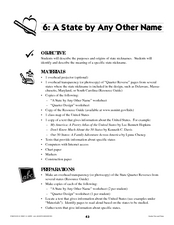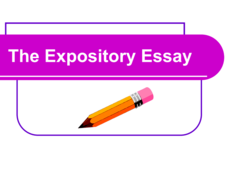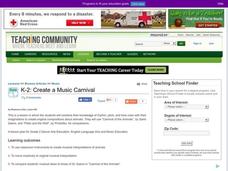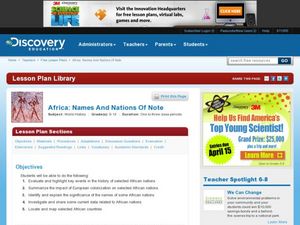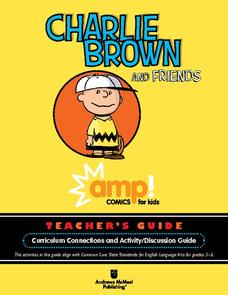Curated OER
A Lifetime of Savings
Sometimes people who seem to lead what would be considered an ordinary life do extraordinary things. Such was the case with Oseola McCarty, who donated a large sum of money for a university scholarship fund in her name. Oseala lived her...
Curated OER
Jack Be Nimble
Students recite the poem "Jack Be Nimble". In this poetry lesson, students read the poem and discuss other action words to use instead of jump. They rewrite the poem using their own name and a new action word.
Curated OER
Reflections
In this reflections worksheet, 10th graders solve and complete 34 different problems that include determining various reflections. First, they trace the figure and draw its reflection in each line. Then, 10th graders use the diagram...
Curated OER
NEWTON'S 3RD LAW
High schoolers examine the formal definition of Newton's 3rd law: "forces always originate in pairs, equal in magnitude and opposite in direction." --The informal, qualitative version: "Each action has an equal and opposite reaction."
Curated OER
Johnny Appleseed
Students explore the life of Johnny Appleseed. In this Johnny Appleseed instructional activity, students read the book Johnny Appleseed. Students complete worksheets that demonstrate their knowledge of letter names and sounds. Students...
Curated OER
Coordinate Plane
In this coordinate plane learning exercise, 10th graders solve and graph 21 different problems that include various pairs of points. First, they write the ordered pair for each point on the first grid. Then, students name the quadrant in...
Curated OER
My Name is___________.
Read to gain an understanding of the author's intent or purpose. Learners analyze a persuasive text, identify the author's purpose, and evaluate the claims used as support. They then compose a persuasive essay of their own.
Curated OER
A State By Any Other Name
Learning about the fifty states can be motivating. After listening to books, pupils discuss and learn about the nicknames of various states. This is an interesting way to review the locations and characteristics of the states.
Curated OER
Re-Name That Tune
Young scholars select a familiar children's tune and redesign it by rewriting the lyrics, writing a play, a dance, a storybook or a puppet show. Students work in groups and share their finished project with their classmates.
Curated OER
Origins and Identity
Students examine how to research their family backgrounds. They conduct interviews with various family members, create a family tree, and present their family tree to the class.
Curated OER
Chrysanthemum
Our uniqueness should be celebrated, not teased. The story Chrysanthemum addresses having a distinct name and dealing with different perceptions. Pre- and post-reading questions are listed to help your learners understand...
jc-schools
The Expository Essay
Did you ever create an awesome graphic organizer only to find that your class was completely baffled by how to use it? This resource not only provides you with a great graphic organizer for a standard five-paragraph essay, but also...
Curated OER
Create a Music Carnival
This outstanding lesson will encourage your students to combine their knowledge of rhythm, pitch, tone and color with their imaginations to create original compositions about animals. They create a music carnival to "Peter and the Wolf"...
Scholastic
It's a Whatchamacallit
Learners formulate new applications for simple machines in an original invention that solves a common problem. They brainstorm ideas for a new product using simple machines and communicate a finished project through an oral,...
Curated OER
Africa: Names and Nations of Note
Students explore Africa. In this global studies lesson, students research the history of African nations, noting the impact of European colonization and other historical events. Students design posters about the nations they research.
Andrews McMeel Publishing
Charlie Brown and Friends
Charles Schulz' Charlie Brown and Friends, a collection of Peanuts comic strips, provides young readers with an opportunity to engage in full-class discussions, work in groups to examine how Schulz develops his characters, and...
Curated OER
The Peanut Wizard
Students read and discuss information regarding George Washington Carver and how the peanut became cultivated in the southern colonies of the United States. In this George Washington Carver lesson, students develop vocabulary that...
NFPA
Sparky's Birthday Surprise
Fire safety is a hot topic for kids! With this resource, little ones will read, color, draw, and play as they are learning about prevention and, as an added bonus, practice naming shapes, counting, and adding numbers! Reading, math, and...
Curated OER
"Old Glory"
Youngsters study and discuss the history and importance of the American Flag. They explain the meaning of the Stars and Stripes, the name "Old Glory," and discover when and how the flag is displayed. This well-designed plan has many...
Curated OER
Coordinate Plane Transformations
Geometric transformations are explored by high schoolers. They will create a set of instructions for plotting coordinates representing an original transformation of a real-world figure. These instructions are shared with middle...
National Endowment for the Humanities
Arabic Poetry: Guzzle a Ghazal!
Students research the evolution and cultural significance of the Arabic ghazal form of poetry. They, in groups, compose an original ghazal poem and read it aloud to the class.
Music Fun
Practice Boards
FACE it. Every Good Boy Deserves Fruit! (And so do girls.) Provide young musicians with music worksheets that enable them to practice musical notation. The six boards included in the packet are templates that focus on notes, rests,...
Curated OER
Decoding the First Alphabets: Not as Simple as A, B, C
Explore early writing systems and their significance in understanding the development of past civilizations. In groups, learners research early writing systems and then present their findings to the rest of the class. They teach their...
Curated OER
Comparative Adjectives
Provide practice for your class transforming adjectives into comparative and superlative forms using -er and -est. Learners do so, first with 11 adjectives, then for 10 more that end in -y, so they must...







